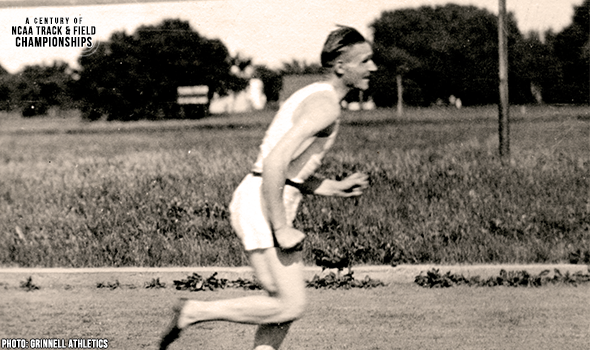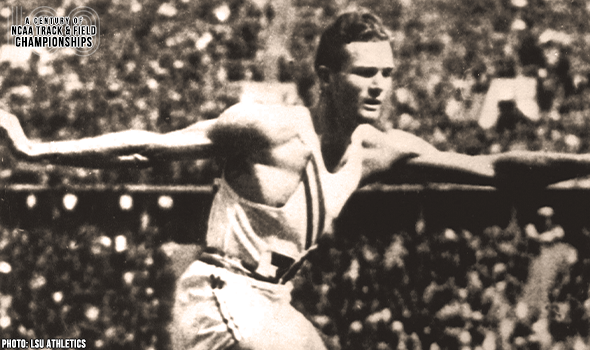
Scott One-Upped Himself In 1978
Steve Scott had no chance to win a fourth-straight NCAA Division II 1500-meter title in 1978.
That’s because UC Irvine had moved up to Division I.
However, Scott had already shown he was more than ready for the challenge in 1977, when he finished as runner-up at the NCAA Division I meet a week after becoming the first NCAA DII athlete to complete the 800-1500 double.
In fact, Scott entered the 1978 NCAA DI final at Hayward Field as one of the favorites, having won the 1977 AAU national title. He even had some previous success at Hayward Field, where he gave the Prefontaine Classic its first sub-4 mile in 1977 and was a surprise finalist at the 1976 U.S. Olympic Trials, finishing seventh.
But, like everyone, Scott – a native of Upland, California – knew most in the crowd would be cheering for Oregon’s Matt Centrowitz, a 1976 Olympian running his final race as a collegian at Hayward Field. “I know that nobody wants to win more than me,” Centrowitz told John Conrad of the Eugene Register-Guard before the final.
Neither Scott nor Centrowitz wanted a repeat of the 1977 race, in which Scott found himself boxed in when the finishing kicks started and Centrowitz watched from the stands after not making the final.
So, shortly after the first lap, Scott went to the lead and had his closest challenge from Centrowitz all the way until the bell lap began. Scott maintained the lead as Centrowitz was passed entering the backstretch by East Tennessee State’s Ray Flynn, who stuck with Scott until the finish as Scott won by a tenth of a second in 3:37.6.
Centrowitz, who ended up sixth, was somewhat surprised by Scott’s strategy: “I knew he was capable of running strong the whole way, but I didn’t think he’d do it. He really wanted to win it.”
Scott agreed with that observation, saying “I dreamed all week of taking a victory lap after the race.”
Interestingly, the victory by Scott didn’t make him the first Anteater to win an NCAA Division I crown, as Mauricio Bardales got that honor the night before by winning the decathlon with 8007 points.
Scott went on to become one of America’s best-ever milers, breaking Jim Ryun’s 3:51.1 American record from 1967 and becoming the first American to run sub-3:50 – his PR of 3:47.69 still rates as second-best by an American.
In 1999, Scott became a coach, starting the track & field and cross country programs at Cal State San Marcos – whose women won three NAIA national cross country titles 2009-11 (the men were runners-up in ’11) – before retiring in 2018.
The NCAA and collegiate track & field will mark a momentous milestone in the spring of 2021 -- the 100th anniversary of the NCAA Championships and with that, the NCAA Track & Field Championships. In June 1921, the University of Chicago hosted the first track & field championships in NCAA history.
This point can’t be emphasized enough: Not only was the event the first for NCAA track & field, but the first championships for any sport under the sponsorship of the NCAA.
To celebrate, over each of the next 365 days, the U.S. Track & Field and Cross Country Coaches Association (USTFCCCA) will celebrate moments, student-athletes, and coaches that have made a century’s worth of championships special. From humble beginnings to important historical milestones to the modern-day, collegiate track & field has evolved with the American society.
The 2021 edition of the NCAA Division I Outdoor Track & Field Championships begin with preliminary round action on May 27-29 in Jacksonville, Fla., and College Station, Texas. The championships final site and culmination of the celebration is slated for June 9-12, 2021 at the newly rebuilt Hayward Field in Eugene, Ore.

SIU’s Roggy Dominated The Javelin In 1978
Bob Roggy won the javelin title at the 1978 NCAA DI Outdoor T&F Championships by more than 20 feet. Roggy qualified first for the final with a MR heave of 89.30m (293‑0).

Makusha Made History In Bowerman Year Of 2011
Ngoni Makusha became just the fourth man in meet history to win individual titles in both the 100 and LJ. It was his 3rd career LJ crown and he set a CR in the 100 of 9.89.

George Mason’s Gage Shocked The NCAA LJ In 1988
Nena Gage won the long jump at the 1988 NCAA DI Outdoor T&F Championships in a shocking upset over Gail Devers.

Texas’ Thompson Marveled In NCAA Distance Events
Jerry Thompson won three career distance titles at the NCAA Outdoor T&F Championships. His first came in 1943. Then he won again in 1947 & 1948 after serving in World War II.

Grinnell’s Paulu Sprinted To NCAA History
Leonard Paulu was the first athlete to complete the 100-200 double in NCAA Outdoor Track & Field Championships history in 1922. That also made him the 1st to win back-to-back 100 titles, too.

Scott Won Back-To-Back NCAA Hammer Titles
Candice Scott won back-to-back hammer throw titles at the NCAA DI Outdoor T&F Championships in 2003 & 2004. Scott set a meet record of 69.77m (228-11) in that first year.

Drouin Soared To The Bowerman In 2013
Derek Drouin won two career HJ titles at the NCAA DI Outdoor T&F Championships. When Drouin won in 2013, he was only the fourth man to clear 2.34m (7-8) in meet history.

Watts Made Quick Work Of NCAA 400
Quincy Watts set a meet record in the 400 of 44.00 at the 1992 NCAA DI Outdoor Track & Field Championships. It lasted 25 years until 2017.

Iowa State’s Koll Rolled To 5K-10K Crowns
Lisa Koll won three career titles at the NCAA DI Outdoor T&F Championships in dominant fashion. Her average margin of victory in those 5K & 10K races was 37.73 seconds.

LSU’s Hardin Completed Unique 440-220H Double Twice
The nearly unheard of 440-220H double was so nice that Glenn Hardin did it twice! Hardin became the first to do so in meet history in 1933 and then swept them again in 1934.

